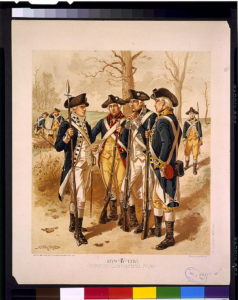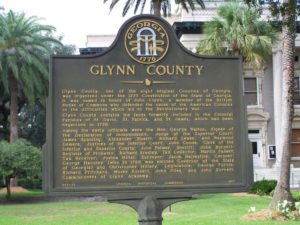September brings the beginning of another school year and the beginning of the Georgia History Festival. The Georgia History Festival is the signature K-12 educational program of the Georgia Historical Society. This year, the Georgia History Festival theme is “Ensuring Liberty and Justice for All.” For the month of September, #MarkerMondays will focus on the ratification of the United States Constitution and the Georgians who played a role in the history of creating the document.
This week’s #MarkerMonday highlights the life of George Handley, one of the delegates to attend Georgia’s special convention to ratify the United State Constitution. George Handley was born in Sheffield, England, on February 9, 1752. Very little is known about Handley’s early life in Great Britain. He arrived in the colony of Georgia in May 1775 and joined the patriot cause during the American Revolutionary War. In January 1776, Handley was named first lieutenant of the 1st Georgia Regiment, rising to the rank of lieutenant colonel. He served along the South Carolina and Georgia borders during the first four years of the war before being captured by British forces in 1780 and held as a prisoner of war in Charleston, South Carolina, until 1782.

Ogden, Henry Alexander, Artist. Infantry: Continental Army, -1783, IV / H.A. Ogden ; lith. by G.H. Buek & Co., N.Y. United States, ca. 1897. Photograph. https://www.loc.gov/item/92515475/.
Following the war, he entered local and state politics, maintaining residences in both Glynn and Richmond County. At the state level, Handley served as secretary of the executive council in 1785 and 1786, before becoming inspector-general of the militia. He was also one of the Glynn County delegates to the state convention that unanimously ratified the U.S. Constitution in 1788. Georgia’s lawmakers and farmers hoped that a stronger federal government would assist the state in its negotiations with the Creek Nation, which claimed large portions of Georgia as part of its land. On 26 January 1788, Handley became Governor of Georgia, serving a one-year term primarily focusing on mitigating the hostilities between the Creek Nation and Georgians along the frontier. He also presided over efforts to revise the state’s constitution using the recently ratified U.S. Constitution as a model. The convention discarded the old state charter and created a new constitution, which granted the governor the power to act in times of crisis. After his term as governor, Handley served one year as a Glynn County representative under the new state government. In 1789, he was appointed Collector of the Port of Brunswick by President George Washington. The following year, Handley moved to Augusta, Georgia, and served as a justice of the peace. In September 1793, George Handley died at the home of J. Hammond at Rae's Hall, Georgia.
Explore the links below to learn more about the life of George Handley and the United States Constitution.
GHS is proud to house Abraham Baldwin’s Draft Copy of the U.S. Constitution in the Georgia Historical Society Image Catalog.
GHS’ Education Blog, Sophia’s Schoolhouse, has created a series of videos to relating to the United States Constitution and Constitution Day. A complete Episode Guide of all videos can be viewed on the Sophia’s Schoolhouse blog.
- Episode 17: Top Ten Reasons to Study the US Constitution
- Episode 18: Get to Know Abraham Baldwin
- Episode 19: Understanding the Constitutional Convention
- Episode 20: Georgians React to the Constitution
New Georgia Encyclopedia (George Handley)
New Georgia Encyclopedia (Constitutional Conventions)
Coastal Georgia Genealogy and History: George Handley
Georgia Info: George Handley Born (part of the This Day in Georgia History series)
Georgia Info: George Handley Elected Governor (part of the This Day in Georgia History series)
Geni.com: Governor George Handley
Further Reading
The Georgia Historical Quarterly has published an article related to Georgia’s special convention to ratify the United States Constitution which can be accessed on JSTOR. If your library does not have access to JSTOR, you can go to www.jstor.org and create a free MyJSTOR Account.
- Coulter, E. M. "Minutes of the Georgia Convention Ratifying the Federal Constitution." The Georgia Historical Quarterly10, no. 3 (1926): 223-37.
- Abbot, William W. "The Structure of Politics in Georgia: 1782-1789." The William and Mary Quarterly14, no. 1 (1957): 47-65. doi:10.2307/1917371.
Related #MarkerMonday Posts
Summer Home of Joseph Habersham (Posted September 3, 2018)
Georgia’s State Capital (Posted September 10, 2018)
William Few Signer of the U.S. Constitution (Posted September 17, 2018)

